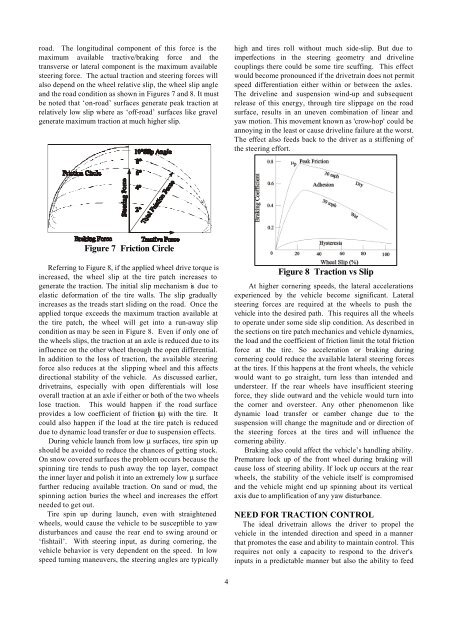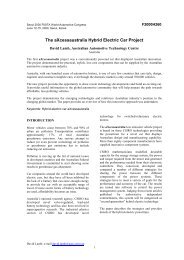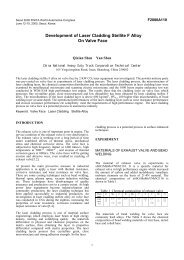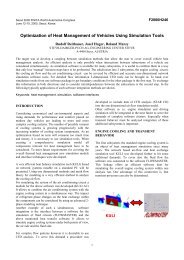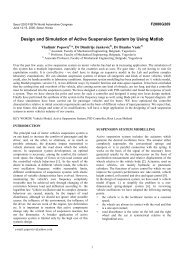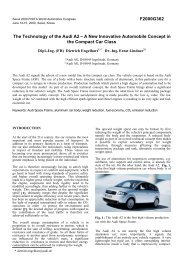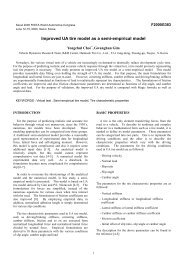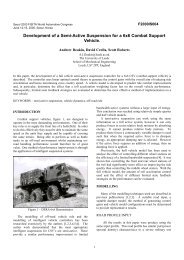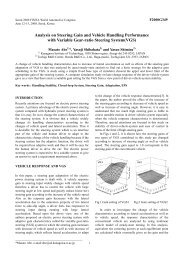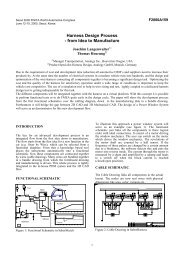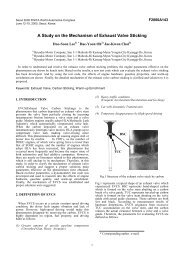All-Wheel Drive / Four-Wheel Drive Systems and Strategies
All-Wheel Drive / Four-Wheel Drive Systems and Strategies
All-Wheel Drive / Four-Wheel Drive Systems and Strategies
You also want an ePaper? Increase the reach of your titles
YUMPU automatically turns print PDFs into web optimized ePapers that Google loves.
oad. The longitudinal component of this force is the<br />
maximum available tractive/braking force <strong>and</strong> the<br />
transverse or lateral component is the maximum available<br />
steering force. The actual traction <strong>and</strong> steering forces will<br />
also depend on the wheel relative slip, the wheel slip angle<br />
<strong>and</strong> the road condition as shown in Figures 7 <strong>and</strong> 8. It must<br />
be noted that ‘on-road’ surfaces generate peak traction at<br />
relatively low slip where as ‘off-road’ surfaces like gravel<br />
generate maximum traction at much higher slip.<br />
high <strong>and</strong> tires roll without much side-slip. But due to<br />
imperfections in the steering geometry <strong>and</strong> driveline<br />
couplings there could be some tire scuffing. This effect<br />
would become pronounced if the drivetrain does not permit<br />
speed differentiation either within or between the axles.<br />
The driveline <strong>and</strong> suspension wind-up <strong>and</strong> subsequent<br />
release of this energy, through tire slippage on the road<br />
surface, results in an uneven combination of linear <strong>and</strong><br />
yaw motion. This movement known as 'crow-hop' could be<br />
annoying in the least or cause driveline failure at the worst.<br />
The effect also feeds back to the driver as a stiffening of<br />
the steering effort.<br />
Figure 7 Friction Circle<br />
Referring to Figure 8, if the applied wheel drive torque is<br />
increased, the wheel slip at the tire patch increases to<br />
generate the traction. The initial slip mechanism is due to<br />
elastic deformation of the tire walls. The slip gradually<br />
increases as the treads start sliding on the road. Once the<br />
applied torque exceeds the maximum traction available at<br />
the tire patch, the wheel will get into a run-away slip<br />
condition as may be seen in Figure 8. Even if only one of<br />
the wheels slips, the traction at an axle is reduced due to its<br />
influence on the other wheel through the open differential.<br />
In addition to the loss of traction, the available steering<br />
force also reduces at the slipping wheel <strong>and</strong> this affects<br />
directional stability of the vehicle. As discussed earlier,<br />
drivetrains, especially with open differentials will lose<br />
overall traction at an axle if either or both of the two wheels<br />
lose traction. This would happen if the road surface<br />
provides a low coefficient of friction (µ) with the tire. It<br />
could also happen if the load at the tire patch is reduced<br />
due to dynamic load transfer or due to suspension effects.<br />
During vehicle launch from low µ surfaces, tire spin up<br />
should be avoided to reduce the chances of getting stuck.<br />
On snow covered surfaces the problem occurs because the<br />
spinning tire tends to push away the top layer, compact<br />
the inner layer <strong>and</strong> polish it into an extremely low µ surface<br />
further reducing available traction. On s<strong>and</strong> or mud, the<br />
spinning action buries the wheel <strong>and</strong> increases the effort<br />
needed to get out.<br />
Tire spin up during launch, even with straightened<br />
wheels, would cause the vehicle to be susceptible to yaw<br />
disturbances <strong>and</strong> cause the rear end to swing around or<br />
‘fishtail’. With steering input, as during cornering, the<br />
vehicle behavior is very dependent on the speed. In low<br />
speed turning maneuvers, the steering angles are typically<br />
Figure 8 Traction vs Slip<br />
At higher cornering speeds, the lateral accelerations<br />
experienced by the vehicle become significant. Lateral<br />
steering forces are required at the wheels to push the<br />
vehicle into the desired path. This requires all the wheels<br />
to operate under some side slip condition. As described in<br />
the sections on tire patch mechanics <strong>and</strong> vehicle dynamics,<br />
the load <strong>and</strong> the coefficient of friction limit the total friction<br />
force at the tire. So acceleration or braking during<br />
cornering could reduce the available lateral steering forces<br />
at the tires. If this happens at the front wheels, the vehicle<br />
would want to go straight, turn less than intended <strong>and</strong><br />
understeer. If the rear wheels have insufficient steering<br />
force, they slide outward <strong>and</strong> the vehicle would turn into<br />
the corner <strong>and</strong> oversteer. Any other phenomenon like<br />
dynamic load transfer or camber change due to the<br />
suspension will change the magnitude <strong>and</strong> or direction of<br />
the steering forces at the tires <strong>and</strong> will influence the<br />
cornering ability.<br />
Braking also could affect the vehicle’s h<strong>and</strong>ling ability.<br />
Premature lock up of the front wheel during braking will<br />
cause loss of steering ability. If lock up occurs at the rear<br />
wheels, the stability of the vehicle itself is compromised<br />
<strong>and</strong> the vehicle might end up spinning about its vertical<br />
axis due to amplification of any yaw disturbance.<br />
NEED FOR TRACTION CONTROL<br />
The ideal drivetrain allows the driver to propel the<br />
vehicle in the intended direction <strong>and</strong> speed in a manner<br />
that promotes the ease <strong>and</strong> ability to maintain control. This<br />
requires not only a capacity to respond to the driver's<br />
inputs in a predictable manner but also the ability to feed<br />
4


